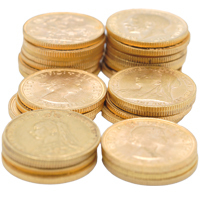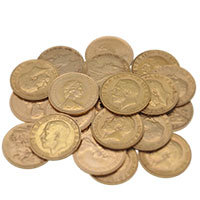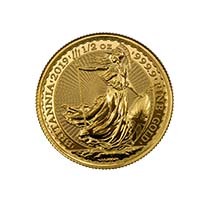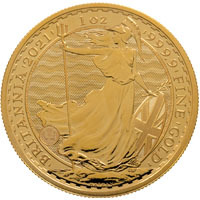Do I Need To Pay CGT On Bullion Coins?
Capital Gains Tax becomes payable on the profit you make over the tax-free allowance when you sell, gift or exchange assets in a certain financial year. The official term used by HMRC is 'dispose'.
Currently, the personal tax-free profit allowance is £12,300 in one financial year. This is the level set by the government for the financial year 2022-23; the CGT threshold is reviewed annually and as of November 2022 the government intends to reduce this tax-free threshold in the coming year:
| Financial Year | CGT Personal Allowance |
| 2022-2023 | £12,300 |
| 2023-2024 | £6,000 |
| 2024-2025 | £3,000 |
| 2025-2026 | TBC |
If your profit is less than the threshold, then you are within your CGT allowance and won't be liable for the tax. £12,300 may seem like a fairly high level, but if you're selling assets like property, art or gold bullion, it can be all too easy to exceed the threshold.
Remember, CGT applies to the current financial year but is based on any profit you make on the original price you paid, regardless of when you purchased the assets. If you bought some gold bullion, say, ten years ago and have seen it steadily increase in value, you might find that the profit you make when you sell it has used up a large proportion of your annual CGT allowance. Any further sales you make in the same year could tip you over the threshold, resulting in you being taxed at 10-28%. The actual rate depends on the assets sold and your personal circumstances, but nevertheless, it can represent a sizeable dent in your profits.
There are some other reliefs from CGT available, such as chattels exemptions. As we are unable to provide specific financial advice on your situation, we recommend you seek professional guidance.
While we are required by UK law to keep records of all transactions with The Britannia Coin Company for seven years, we do not forward any details to HMRC unless specifically requested to do so.
How Do You Avoid Capital Gains Tax On Gold?
Striving to avoid Capital Gains Tax is perfectly legal. However, evading Capital Gains Tax will likely land you in very hot water with the taxman!
If you are wondering how to avoid CGT in respect of gold, there’s a few options to consider:
Buy CGT-Exempt Gold Coins
Consider investing in coins which are legal tender pound sterling, the most well-known being:
- Britannias
- Sovereigns (post-1837)
- Queen's Beasts
- Tudor Beasts
It's not just the gold versions of these coins which are CGT exempt - the silver and platinum editions also benefit from the exemption.
Keep Within The CGT Allowance
If you already have CGT-liable coins or are considering purchasing gold coins which are subject to CGT, manage your liability in a few ways:
- Consider selling one part of your collection in one financial year and then another part in the next financial year: sell some in March and some in April
- Offset any losses from the disposal of assets against the sale of other assets which are in profit
- Make sure the profit on the disposal of your gold coins falls within your annual tax-free allowance
- Work out if any of your coins can qualify for chattels exemption: you could benefit from a £6,000 allowance if your coin(s) qualify, but you'll need to consult a financial professional for assistance
We don't believe CGT should deter investors from purchasing CGT-liable coins: in some cases the premiums and/or availability could be better than that of British coins!
For example, gold Krugerrands are recognisable world-wide and are usually readily available at low premiums. Investors looking for the lowest premiums find that Krugerrands can be an attractive buy, especially if the CGT threshold is not a concern.
Capital Gains Tax On Gold Bars
Gold bars are available in a range of sizes, making them attractive investment propositions with flexible buying and selling options.
However, whilst you won't pay VAT on transactions involving investment gold bars, you could be liable for CGT on them. Gold bars are not UK legal currency, therefore they are liable to Capital Gains Tax if a profit over the threshold is realised when you sell.
Will I Pay CGT On Gold Coins?
Fortunately, you can buy certain gold coins safe in the knowledge that they are exempt from CGT – so you won't be liable for capital gains tax, no matter how much profit you make when you dispose of them.
There are numerous types of gold investment coins that are available from several countries and in a range of denominations. You could, for example, choose to buy South African Krugerrands, Mexican gold Pesos, American Eagles or Austrian gold Philharmonics. Beware though – whilst these fascinating gold coins will add diversity and interest to your portfolio, they are not CGT-exempt.
The only gold coins that are not liable for CGT are those that are UK legal currency, such as gold Britannias and gold Sovereigns from The Royal Mint.
Capital Gains Tax On Silver Bullion
The fact that UK legal currency encompasses coins such as the silver Britannia means they benefit from the same Capital Gains Tax exemption as British gold coins.
Put simply, any Royal Mint silver investment coin will not be liable to CGT when it's sold at a later date and profit is realised on it.
Alas, all investment silver coins sold for physical possession in the United Kingdom are subject to VAT at the standard rate (currently 20%), so that inconvenience can make investing in silver less attractive than gold.
CGT On Platinum And Palladium
Although retail sales of investment platinum coins in the UK are minuscule compared to gold coins and silver coins - mostly because of the VAT payable on platinum - there are several UK legal currency platinum coins for the serious investor. The most popular of these are platinum Britannias. These Royal Mint Pt coins have a legal tender face value and count as Pound sterling coins, meaning they also benefit from the exemption from Capital Gains Tax.
As for palladium, The Royal Mint does not currently offer or produce any palladium coinage denominated in Pounds sterling, so there's no practical avenue for UK investors to avoid paying CGT on profits made when selling investment palladium.
UK Capital Gains Tax Law On Bullion Coins
Why are UK legal tender coins exempt from CGT?
Well, in the most simple sense, HMRC cannot apply Capital Gains Tax to the unit of account.
This is codified in Section 21 (1)(b) of the Taxation of Chargeable Gains Act 1992. The Act forms the legal basis which underpins the exemption of legal tender Pound sterling coins from Capital Gains Tax. The Act states:
'(1) All forms of property shall be assets for the purposes of this Act, whether situated in the United Kingdom or not, including —
(a) options, debts and incorporeal property generally, and
(b) any currency other than sterling, and
(c) any form of property created by the person disposing of it, or otherwise coming to be owned without being acquired.'
This law is specifically mentioned in HMRC's official internal manual. Here's a couple of quotes.
Currency in sterling is not an asset for capital gains purposes. It is the unit by reference to which capital gains are measured.
--- CG12602 - TCGA92/S21 (1)(b)
Coins are to be regarded as currency only if they are legal tender at the time of their acquisition or disposal. Coins which are currency but not sterling, for example Krugerrands, are chargeable assets.
Sovereigns minted in 1837 and later years and Britannia gold coins are currency but, like all sterling currency, are exempt because of TCGA92/S21 (1)(b).
--- CG78305
For the coin in question to be treated as UK legal currency, it would need to meet the definitions set out in the Coinage Act 1971, i.e. have been produced by the Royal Mint and can be used to settle debt in a court of law.
British coins which have been officially demonetised are NOT exempt from CGT, which would mean, for example, gold Guineas and hammered gold Unite coins are liable to CGT.
CGT Exempt Gold And Silver Coins
There's a wide range of Royal Mint bullion coins available, all of which are exempt from Capital Gains Tax. Here's our top picks:
| Royal Mint Coin | Our Price |
| Sovereigns (post-1837) | £456.98 |
| Half Sovereigns (post-1837) | £239.70 |
| Gold 1oz Britannias | £1,981.26 |
| Silver 1oz Britannias | £30.00 |
What Are The Best Gold Coins To Invest In?
Although all CGT-exempt gold coins are struck by the Royal Mint, there is still a surprisingly wide choice, in terms of design, value and years minted. Some coins do have an element of rarity value and being able to purchase coins from different years does have an appeal, if you like the idea that your investment portfolio can also be an interesting collection.
The best known legal tender gold coins from the Royal Mint are the gold Sovereign and the gold Britannia, which we offer at very competitive premiums.
Gold Sovereigns
Quite possibly the most revered gold bullion coin, the gold Sovereign is often referred to as 'the chief coin of the world' for its dependable quality and status, ensuring it is always in demand. It was first produced in 1489 on the orders of King Henry VII, and has been adorned with a variety of designs. The most enduring has been St George and the dragon, created by Benedetto Pistrucci. This timeless design first appeared when the Sovereign was relaunched during the reign of George III in 1817.
Full Sovereigns contains 0.2354 troy ounces of gold, struck in 22-carat fineness. It measures 22.05 millimetres in diameter. Half Sovereigns, Double Sovereigns and Quintuple Sovereigns are also available. These are also CGT-exempt.
Gold Britannias
Introduced in 1987, the one-ounce gold Britannia was upgraded from 22-carats to 24-carats in 2013 and contains one troy ounce of pure gold. With a diameter of 32.69 millimetres, it is both larger and heavier than the gold Sovereign. The face value is £100 though the actual value is, of course, many times more.
The gold Britannia is available in ⅒ oz, ¼ oz and ½ oz versions as well as the 1oz coin. The Britannia has also been struck in silver and platinum editions too.
As the name suggests, this sought-after coin bears the image of Britannia, featuring the classic design by Philip Nathan. Britannia, in all her various guises, has appeared on coins circulated in Britain for over 2,000 years, so this instantly recognisable symbol confirms the Gold Britannia's status as a world-leading bullion coin.







.jpg)
